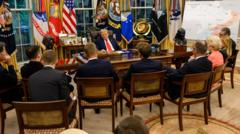President Carter's installation of solar panels in 1979 symbolizes the early push for renewable resources, a legacy that continues to influence the energy discussion today.
**Carter's Solar Legacy: A Beacon for Renewable Energy**

**Carter's Solar Legacy: A Beacon for Renewable Energy**
In the wake of Jimmy Carter's passing, the journey of the White House solar panels serves as a testament to his forward-thinking vision for sustainable energy.
In June 1979, President Jimmy Carter showcased his ambition for energy independence by installing 32 solar panels on the White House roof. This initiative emerged during an era marked by an oil embargo from Arab nations; there was an urgent desire within the United States to reduce its dependence on foreign oil supplies. “No one can ever embargo the sun or interrupt its delivery to us,” Carter remarked during the solar array's introduction, highlighting the importance of harnessing renewable energy sources.
However, just seven years later, the panels were dismantled under President Ronald Reagan, who initiated a renovation of the White House roof. The removal of the panels did not extinguish their impact; instead, they found new life at a small college in Maine, where they continued to generate power for several years. From there, they were dispersed across various locations throughout the United States and even China, expanding their legacy beyond the walls of the White House.
Experts note that Carter's foresight placed him ahead of the curve in recognizing the potential of solar energy. Ernest Moniz, who served as energy secretary under Barack Obama and currently leads the Energy Futures Initiative, reflects upon Carter's vision. "There’s no doubt Jimmy Carter was well ahead of his time," Moniz states, underscoring the significance of Carter's commitment to renewable energy at a time when climate change awareness was limited.
Decades since the panels' installation, the dialogue surrounding renewable energy has gathered momentum, with new technology emerging and a global shift toward sustainability. Despite their removal and the country's fluctuating relationship with renewable resources over the years, Carter’s initial investment in solar technology paved the way for future generations to explore and embrace energy solutions that honor environmental integrity.



















